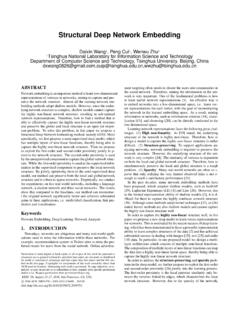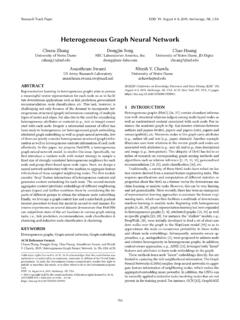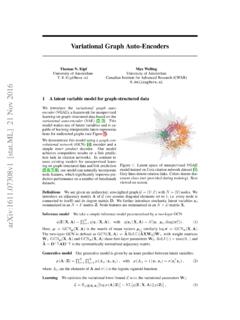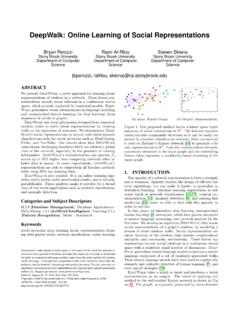Transcription of Representation Learning on Graphs: Methods and Applications
1 Representation Learning on Graphs: Methods and ApplicationsWilliam L. of Computer ScienceStanford UniversityStanford, CA, 94305 AbstractMachine Learning on graphs is an important and ubiquitous task with Applications ranging from drugdesign to friendship recommendation in social networks. The primary challenge in this domain is findinga way to represent, or encode, graph structure so that it can be easily exploited by machine learningmodels. Traditionally, machine Learning approaches relied on user-defined heuristics to extract featuresencoding structural information about a graph ( , degree statistics or kernel functions).
2 However,recent years have seen a surge in approaches that automatically learn to encode graph structure intolow-dimensional embeddings, using techniques based on deep Learning and nonlinear dimensionalityreduction. Here we provide a conceptual review of key advancements in this area of representationlearning on graphs, including matrix factorization-based Methods , random-walk based algorithms, andgraph convolutional networks. We review Methods to embed individual nodes as well as approachesto embed entire (sub)graphs. In doing so, we develop a unified framework to describe these recentapproaches, and we highlight a number of important Applications and directions for future IntroductionGraphs are a ubiquitous data structure, employed extensively within computer science and related fields.
3 Socialnetworks, molecular graph structures, biological protein-protein networks, recommender systems all of thesedomains and many more can be readily modeled as graphs, which capture interactions ( , edges) betweenindividual units ( , nodes). As a consequence of their ubiquity, graphs are the backbone of countless systems,allowing relational knowledge about interacting entities to be efficiently stored and accessed [2].However, graphs are not only useful as structured knowledge repositories: they also play a key role inmodern machine Learning . Machine Learning Applications seek to make predictions, or discover new patterns,using graph -structured data as feature information.
4 For example, one might wish to classify the role of a proteinin a biological interaction graph [28], predict the role of a person in a collaboration network, recommend newfriends to a user in a social network [3], or predict new therapeutic Applications of existing drug molecules,whose structure can be represented as a graph [21].Copyright 2017 IEEE. Personal use of this material is permitted. However, permission to reprint/republish this material foradvertising or promotional purposes or for creating new collective works for resale or redistribution to servers or lists, or to reuse anycopyrighted component of this work in other works must be obtained from the of the IEEE Computer Society Technical Committee on Data Engineering1 Community structureStructural equivalence / rolesFigure 1:Two different views of a character-character interaction graph derived from the Les Mis erables novel, where twonodes are connected if the corresponding characters interact.
5 The coloring in the left figure emphasizes differences in thenodes global positions in the graph : nodes have the same color if they belong to the same community, at a global contrast, the coloring in the right figure denotes structural equivalence between nodes, or the fact that two nodes playsimilar roles in their local neighborhoods ( , bridging nodes are colored blue). The colorings for both figures weregenerated using different settings of the node2vec node embedding method [27], described in Section 2. Reprinted from[27] with central problem in machine Learning on graphs is finding a way to incorporate information about thestructure of the graph into the machine Learning model.
6 For example, in the case of link prediction in a socialnetwork, one might want to encode pairwise properties between nodes, such as relationship strength or thenumber of common friends. Or in the case of node classification, one might want to include information aboutthe global position of a node in the graph or the structure of the node s local graph neighborhood (Figure 1), andthere is no straightforward way to encode this information into a feature extract structural information from graphs, traditional machine approaches often rely on summary graphstatistics ( , degrees or clustering coefficients) [6], kernel functions [57], or carefully engineered featuresto measure local neighborhood structures [39].
7 However, these approaches are limited because these hand-engineered features are inflexible , they cannot adapt during the Learning process and designing thesefeatures can be a time-consuming and expensive recently, there has been a surge of approaches that seek tolearnrepresentations that encode structuralinformation about the graph . The idea behind theserepresentation learningapproaches is to learn a mapping thatembeds nodes, or entire (sub)graphs, as points in a low-dimensional vector space,Rd. The goal is to optimizethis mapping so that geometric relationships in this learned space reflect the structure of the original graph .
8 Afteroptimizing the embedding space, the learned embeddings can be used as feature inputs for downstream machinelearning tasks. The key distinction between Representation Learning approaches and previous work is how theytreat the problem of capturing structural information about the graph . Previous work treated this problem as apre-processing step, using hand-engineered statistics to extract structural information. In contrast, representationlearning approaches treat this problem as machine Learning task itself, using a data-driven approach to learnembeddings that encode graph we provide an overview of recent advancements in Representation Learning on graphs, reviewing tech-niques for representing both nodes and entire subgraphs.
9 Our survey attempts to merge together multiple, dis-parate lines of research that have drawn significant attention across different subfields and venues in recent1 For this and all subsequent reprinted figures, the original authors retain their copyrights, and permission was obtained from thecorresponding 2: A, graph structure of the Zachary Karate Club social network, where nodes are connected if the correspondingindividuals are friends. The nodes are colored according to the different communities that exist in the , Two-dimensional visualization of node embeddings generated from this graph using the deepwalk method (Section ) [46].
10 The distances between nodes in the embedding space reflect proximity in the original graph , and the node embeddings arespatially clustered according to the different color-coded communities. Reprinted with permission from [46, 48].years , node embedding Methods , which are a popular object of study in the data mining community, andgraph convolutional networks, which have drawn considerable attention in major machine Learning venues. Indoing so, we develop a unified conceptual framework for describing the various approaches and emphasizemajor conceptual focus our review on recent approaches that have garnered significant attention in the machine learningand data mining communities, especially Methods that are scalable to massive graphs ( , millions of nodes)and inspired by advancements in deep Learning .








